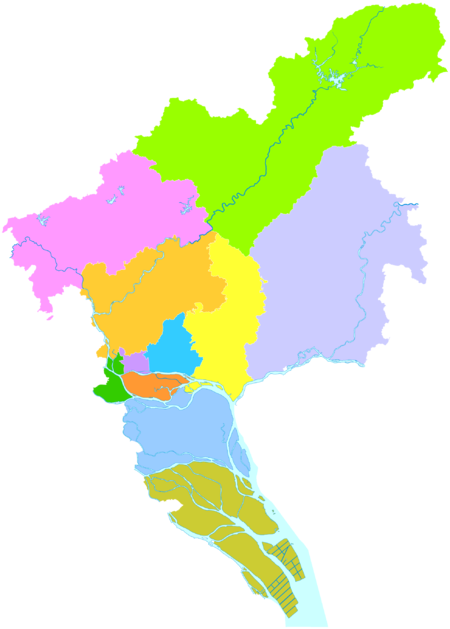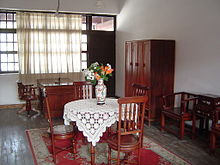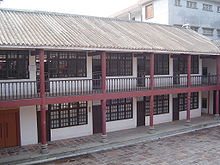Guangzhou
![]()
This article is about the place. For the asteroid see (3048) Guangzhou.
Guangzhou, exonym: Canton (Chinese 廣州市 / 广州市, pinyin Guǎngzhōu Shì, IPA (High Chinese) [kwɑŋ21ʈʂɔw5], W.-G. Kuang³-chou¹, Jyutping Gwong2zau1Si5, English Canton, obsolete Post Kwong Chow, abbreviated 穗, Suì, Jyutping Seoi6), is a city in the south of the People's Republic of China. It has 11,114,200 inhabitants in the geographic urban area and 14,043,500 inhabitants in the administrative urban area (as of year-end 2011 and 2016, respectively). It is the capital of Guangdong Province and a major industrial and commercial center. The region is also known as the "Factory of the World".
Guangzhou is the largest city in the Pearl River Delta, one of the largest contiguous urban landscapes (megalopolises) in the world. In addition to Guangzhou, the Pearl River Delta includes the megacities of Hong Kong, Shenzhen, Dongguan, Foshan, Jiangmen, Huizhou, Zhongshan and Zhuhai, with a combined population of more than 60 million.
The name Canton, used in German (and similarly in other Western languages), derives from the name of the province Guangdong. In China, Guangzhou is also called 穗城, Suìchéng, Jyutping Seoi6sing4 - "City of Ears" or 羊城, Yángchéng, Jyutping Joeng4sing4 - "City of Goats". The landmark of the city is a statue of five goats.
The proximity to Hong Kong - as in the entire Pearl River Delta - has had a promoting influence on economic development. In Guangzhou, the Canton Fair, China's largest import and export fair, is held twice a year - in spring and autumn.
In October 2010, the world's tallest TV tower at the time (Canton Tower, 600 m) was opened here. In 2012, this record went to the Tokyo Skytree.
Geography
Climate
Guangzhou is located on the Pearl River. Due to its geographical location, Guangzhou has a subtropical humid monsoon climate with an average annual temperature of 22 °C. Most precipitation (annual average: 1,982 mm) falls in the rainy season from April to August.
| Monthly average temperatures and precipitation for Guangzhou
Source: wetterkontor.de | ||||||||||||||||||||||||||||||||||||||||||||||||||||||||||||||||||||||||||||||||||||||||||||||||||||||||||||||||||||||||||||||||||||||||||||||||||||||||||||||||||||||||||||||||||||||||||||||||||||||||||||||||||||||||||||||||||||||||||||||||||||||||||||
Administrative structure
At the county level, the sub-provincial city of Guangzhou is composed of eleven municipalities. The People's Government of Guangzhou is located in Yuexiu Municipality. On April 28, 2005, Dongshan and Fangcun Municipal Districts were dissolved and incorporated into Yuexiu and Liwan. In addition, Nansha Municipality was spun off from Panyu, and Luogang Municipality was established from parts of Baiyun, Tianhe, Zengcheng, and from part of Huangpu, forming an exclave of the new municipality. In February 2014, Luogang was dissolved again and its area was integrated into Huangpu Municipality. At the same time, the two independent cities of Conghua and Zengcheng were transformed into urban districts.
| Administrative division of Guangzhou | |||||
| Liwan Yuexiu Haizhu Tianhe Baiyun Huangpu Panyu Huadu Nansha Zengcheng Conghua | |||||
| Borough | Chinese name | Hanyu Pinyin | Population | Surface area | Population density |
| Baiyun | Báiyún Qū | 2.222.658 | 795,79 | 2.793 | |
| Conghua | Cónghuà Qū | 593.415 | 1.974,50 | 301 | |
| Haizhu | Hǎizhū Qū | 1.558.663 | 90,40 | 17.242 | |
| Huadu | Huādū Qū | 945.053 | 970,04 | 974 | |
| Huangpu | Huángpù Qū | 831.600 | 484,17 | 1.718 | |
| Liwan | Lìwān Qū | 898.204 | 59,10 | 15.198 | |
| Nansha | Nánshā Qū | 259.899 | 527,65 | 493 | |
| Panyu | Pānyú Qū | 1.764.869 | 786,15 | 2.245 | |
| Tianhe | Tiānhé Qū | 1.432.431 | 96,33 | 14.870 | |
| Yuexiu | Yuèxiù Qū | 1.157.277 | 33,80 | 34.239 | |
| Zengcheng | Zēngchéng Qū | 1.036.731 | 1.616,47 | 641 | |
| Total | 12.700.800 | 7.434,40 | 1.708 | ||

History
Ancient
It is believed that the area around Guangzhou was settled as early as the 9th century BC. During the Qin Dynasty, the city was the capital of Nanhai Prefecture (南海, Nánhǎi, Jyutping Naam4hoi2).
Other historians believe that people settled in 214 BC. According to this theory, the oldest settlement area in present-day Guangzhou was in Panyu (番禺, Pānyú, Jyutping Pun1jyu4). Since then, the area has been continuously inhabited. Panyu grew especially when it became the capital of the Nanyue Kingdom in 206 BC. The Western Han Dynasty annexed the kingdom in 111 BC. Since then, Panyu has been a provincial capital. In 226, the city became the seat of Guang County (廣州 / 广州, Guǎngzhōu, Jyutping Gwong2zau1). People got used to calling the city Guangzhou instead of Panyu.
Trade
For a long time, Guangzhou was the starting point of the so-called "Silk Road by Sea" (海上絲路 / 海上丝路, Hǎi shàng Sīlù, Jyutping Hoi2 Soeng6 Si1lou6). By sea, the city maintained trade relations with South Asian countries such as India and Arabia.
From 1757 to 1842, Guangzhou was the only trading port where foreigners were contractually guaranteed the right to trade.
In 1711, the British East India Company established a trading post in Guangzhou. Emperor Qianlong restricted the right of foreigners to establish branches in Guangzhou to a small area in Guangzhou.
Guangzhou was one of the five treaty ports whose opening was forced by Britain through the Treaty of Nanking after the First Opium War. The other ports were Fuzhou, Xiamen, Ningbo and Shanghai.
20th century
In 1918, Guangzhou became the official name of the city. Panyu has since been called a district in the south of Guangzhou.
Sun Yat-sen prepared the revolution against the emperor in Guangzhou. The military school he built, called Huangpu Junxiao, also Whampoa Military Academy, (黃埔軍校 / 黄埔军校, Huángpŭ Jūnxiào, Jyutping Wong4bou3 Gwan1haau6) is still preserved today and a popular destination.
Japanese troops captured Guangzhou in October 1938 as part of the Canton Operation and held it until September 16, 1945.
After the end of the civil war, renewals led to a higher standard of living for many people in Guangzhou. From the end of the 1970s, the city benefited from the economic reforms introduced by Deng Xiaoping. Economic growth was greatly boosted, especially by its proximity to Hong Kong and its location on the Pearl River.
In the Tianhe district, the 530-meter-high Chow Tai Fook Center, currently the seventh tallest building in the world, was completed in 2016. Together with the 438-meter-high Guangzhou International Finance Center opposite, the CITIC Plaza to the north and the 600-meter-high Canton Tower to the south, the second-highest television tower in the world, it forms an architectural diamond.

Martyrs' Monument

Historical map (around 1888)
_T3_p318_CANTON.jpg)
A Dutch merchant in a tea manufactory in Canton (c. 1828)

Office in Huangpu Junxiao

Whampoa Military Academy or Huangpu Junxiao
Questions and Answers
Q: What is the name of the city in simplified Chinese?
A: The name of the city in simplified Chinese is 广州.
Q: How do you pronounce Guangzhou in Cantonese?
A: Guangzhou is pronounced [kʷɔ̌ːŋ.tsɐ̂u] or [kʷɔ̌ːŋ.tsɐ́u] in Cantonese.
Q: What was the city formerly known as by Westerners?
A: The city was formerly known as Canton by Westerners.
Q: What does Bei-Shang-Guang refer to?
A: Bei-Shang-Guang refers to Beijing, Shanghai and Guangzhou, which are regarded as three of the most popular cities in mainland China.
Q: Where were the 16th Asian Games held?
A: The 16th Asian Games were held in Guangzhou.
Q: Why is it called "The City of Flowers"?
A: It is called "The City of Flowers" because it has a long history and culture related to flowers and plants, such as its flower markets and gardens that have been around for centuries.
Q: Is Guangzhou famous for its food all over the world?
A Yes, Guangzhou is famous for its food all over the world.
Search within the encyclopedia